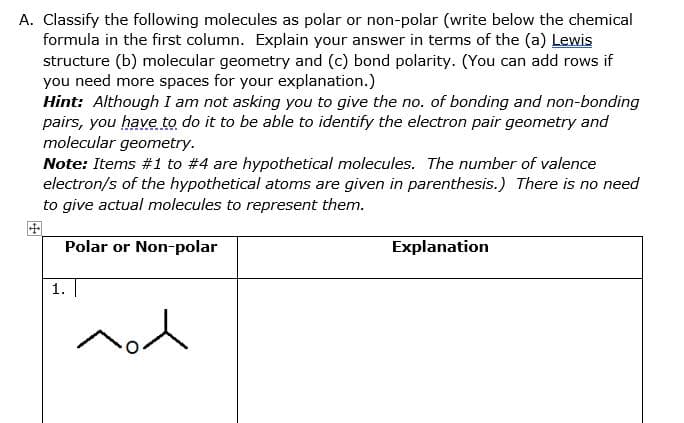A. Classify the following molecules as polar or non-polar (write below the chemical formula in the first column. Explain your answer in terms of the (a) Lewis structure (b) molecular geometry and (c) bond polarity. (You can add rows if you need more spaces for your explanation.) Hint: Although I am not asking you to give the no. of bonding and non-bonding pairs, you have to do it to be able to identify the electron pair geometry and molecular geometry. Note: Items #1 to #4 are hypothetical molecules. The number of valence electron/s of the hypothetical atoms are given in parenthesis.) There is no need to give actual molecules to represent them. Polar or Non-polar Explanation 1. nod
A. Classify the following molecules as polar or non-polar (write below the chemical formula in the first column. Explain your answer in terms of the (a) Lewis structure (b) molecular geometry and (c) bond polarity. (You can add rows if you need more spaces for your explanation.) Hint: Although I am not asking you to give the no. of bonding and non-bonding pairs, you have to do it to be able to identify the electron pair geometry and molecular geometry. Note: Items #1 to #4 are hypothetical molecules. The number of valence electron/s of the hypothetical atoms are given in parenthesis.) There is no need to give actual molecules to represent them. Polar or Non-polar Explanation 1. nod
Principles of Modern Chemistry
8th Edition
ISBN:9781305079113
Author:David W. Oxtoby, H. Pat Gillis, Laurie J. Butler
Publisher:David W. Oxtoby, H. Pat Gillis, Laurie J. Butler
Chapter3: Atomic Shells And Classical Models Of Chemical Bonding
Section: Chapter Questions
Problem 70P: Ozone (O3) has a nonzero dipole moment. In the molecule of O3 , one of the oxygen atoms is directly...
Related questions
Question

Transcribed Image Text:A. Classify the following molecules as polar or non-polar (write below the chemical
formula in the first column. Explain your answer in terms of the (a) Lewis
structure (b) molecular geometry and (c) bond polarity. (You can add rows if
you need more spaces for your explanation.)
Hint: Although I am not asking you to give the no. of bonding and non-bonding
pairs, you have to do it to be able to identify the electron pair geometry and
molecular geometry.
Note: Items #1 to #4 are hypothetical molecules. The number of valence
electron/s of the hypothetical atoms are given in parenthesis.) There is no need
to give actual molecules to represent them.
Polar or Non-polar
Explanation
1.
nod
Expert Solution
This question has been solved!
Explore an expertly crafted, step-by-step solution for a thorough understanding of key concepts.
This is a popular solution!
Trending now
This is a popular solution!
Step by step
Solved in 2 steps with 1 images

Knowledge Booster
Learn more about
Need a deep-dive on the concept behind this application? Look no further. Learn more about this topic, chemistry and related others by exploring similar questions and additional content below.Recommended textbooks for you

Principles of Modern Chemistry
Chemistry
ISBN:
9781305079113
Author:
David W. Oxtoby, H. Pat Gillis, Laurie J. Butler
Publisher:
Cengage Learning

Chemistry: The Molecular Science
Chemistry
ISBN:
9781285199047
Author:
John W. Moore, Conrad L. Stanitski
Publisher:
Cengage Learning

Organic Chemistry: A Guided Inquiry
Chemistry
ISBN:
9780618974122
Author:
Andrei Straumanis
Publisher:
Cengage Learning

Principles of Modern Chemistry
Chemistry
ISBN:
9781305079113
Author:
David W. Oxtoby, H. Pat Gillis, Laurie J. Butler
Publisher:
Cengage Learning

Chemistry: The Molecular Science
Chemistry
ISBN:
9781285199047
Author:
John W. Moore, Conrad L. Stanitski
Publisher:
Cengage Learning

Organic Chemistry: A Guided Inquiry
Chemistry
ISBN:
9780618974122
Author:
Andrei Straumanis
Publisher:
Cengage Learning

Physical Chemistry
Chemistry
ISBN:
9781133958437
Author:
Ball, David W. (david Warren), BAER, Tomas
Publisher:
Wadsworth Cengage Learning,

Chemistry: Matter and Change
Chemistry
ISBN:
9780078746376
Author:
Dinah Zike, Laurel Dingrando, Nicholas Hainen, Cheryl Wistrom
Publisher:
Glencoe/McGraw-Hill School Pub Co